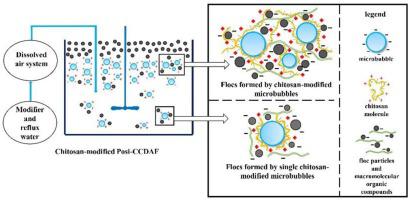Journal of Water Process Engineering ( IF 7 ) Pub Date : 2021-01-01 , DOI: 10.1016/j.jwpe.2020.101847 Yonglei Wang , Wentao Sun , Luming Ding , Wei Liu , Liping Tian , Yinhe Zhao , Mengyu Zhang , Xuelin Wang

|
Water from the Yellow River reservoir is treated by dissolved air flotation (DAF), but the flocs formed are loose and easily desorbed. To solve this problem, a new air flotation process, i.e., Posi-co-coagulation dissolved air flotation (Posi-CCDAF), was developed by combining DAF with microbubble surface modification technology. The feasibility of the Posi-CCDAF process was verified by using chitosan to modify the surfaces of the microbubbles. The optimal dosage ratio of chitosan/coagulant was 0.4, and the optimal pH of the reflux water was 6.00. The removal characteristics of organic pollutants under the optimal conditions were studied. The removal characteristics of natural organic matter (NOM) with different molecular weights before and after adding chitosan were compared, and the removal efficiency of disinfection byproduct precursors was evaluated. Microscopic analysis was used to observe the bubble floc adhesion process and flocs during the copolymerization process before and after the addition of chitosan. The results showed that chitosan promoted the removal of hydrophobic macromolecular organics and the trihalomethane formation potential (THMFP) by CCDAF. On the one hand, the surface of modified microbubbles in Posi-CCDAF was positively charged, which provided electrostatic force to enhance the adhesion of flocs during polymerization; on the other hand, the combination of chitosan and macromolecular organics in water formed a capture network, which made the bubble flocs larger and caused them to adhere tightly, improving the removal effect of air flotation.
中文翻译:

壳聚糖修饰的微泡增强共凝溶解气浮的可行性及机理研究
黄河水库的水通过溶解气浮法(DAF)进行处理,但形成的絮凝物疏松且易于解吸。为了解决这个问题,通过将DAF与微泡表面改性技术相结合,开发了一种新的气浮工艺,即Posi-co-凝聚凝析气浮(Posi-CCDAF)。通过使用壳聚糖修饰微气泡的表面,验证了Posi-CCDAF工艺的可行性。壳聚糖/凝结剂的最佳剂量比为0.4,回流水的最佳pH为6.00。研究了最佳条件下有机污染物的去除特性。比较了加入壳聚糖前后不同分子量的天然有机物(NOM)的去除特性,并评估了消毒副产物前体的去除效率。使用显微镜分析来观察气泡絮凝物的粘附过程以及在加入壳聚糖之前和之后的共聚过程中的絮凝物。结果表明,壳聚糖可促进CCDAF去除疏水性高分子有机物和三卤甲烷形成潜能(THMFP)。一方面,Posi-CCDAF中改性微泡的表面带正电,在聚合过程中提供静电力以增强絮体的附着力。另一方面,壳聚糖和大分子有机物在水中的结合形成了一个捕集网,使泡沫絮状物变大并使其紧密附着,从而提高了气浮的去除效果。使用显微镜分析来观察气泡絮凝物的粘附过程以及在加入壳聚糖之前和之后的共聚过程中的絮凝物。结果表明,壳聚糖可促进CCDAF去除疏水性高分子有机物和三卤甲烷形成潜能(THMFP)。一方面,Posi-CCDAF中改性微泡的表面带正电,在聚合过程中提供静电力以增强絮体的附着力。另一方面,壳聚糖和大分子有机物在水中的结合形成了一个捕集网,使泡沫絮状物变大并使其紧密附着,从而提高了气浮的去除效果。使用显微镜分析来观察气泡絮凝物的粘附过程以及在加入壳聚糖之前和之后的共聚过程中的絮凝物。结果表明,壳聚糖可促进CCDAF去除疏水性高分子有机物和三卤甲烷形成潜能(THMFP)。一方面,Posi-CCDAF中改性微泡的表面带正电,在聚合过程中提供静电力以增强絮体的附着力。另一方面,壳聚糖和大分子有机物在水中的结合形成了一个捕集网,使泡沫絮状物变大并使其紧密附着,从而提高了气浮的去除效果。结果表明,壳聚糖可促进CCDAF去除疏水性高分子有机物和三卤甲烷形成潜能(THMFP)。一方面,Posi-CCDAF中改性微泡的表面带正电,在聚合过程中提供静电力以增强絮体的附着力。另一方面,壳聚糖和大分子有机物在水中的结合形成了一个捕集网,使泡沫絮状物变大并使其紧密附着,从而提高了气浮的去除效果。结果表明,壳聚糖可促进CCDAF去除疏水性高分子有机物和三卤甲烷形成潜能(THMFP)。一方面,Posi-CCDAF中改性微泡的表面带正电,在聚合过程中提供静电力以增强絮体的附着力。另一方面,壳聚糖和大分子有机物在水中的结合形成了一个捕集网,使泡沫絮状物变大并使其紧密附着,从而提高了气浮的去除效果。在聚合过程中提供静电力以增强絮凝物的附着力;另一方面,壳聚糖和大分子有机物在水中的结合形成了一个捕集网,使泡沫絮状物变大并使其紧密附着,从而提高了气浮的去除效果。在聚合过程中提供静电力以增强絮凝物的附着力;另一方面,壳聚糖和大分子有机物在水中的结合形成了一个捕集网,使泡沫絮状物变大并使其紧密附着,从而提高了气浮的去除效果。



























 京公网安备 11010802027423号
京公网安备 11010802027423号